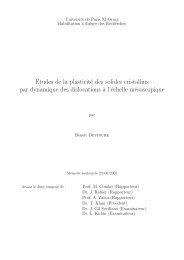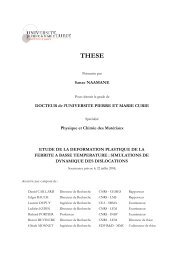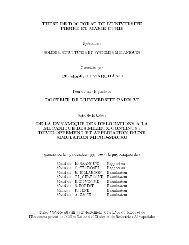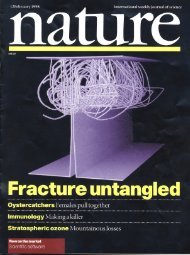Acta Materialia, 58(17) - Laboratoire d'Etude des Microstructures
Acta Materialia, 58(17) - Laboratoire d'Etude des Microstructures
Acta Materialia, 58(17) - Laboratoire d'Etude des Microstructures
You also want an ePaper? Increase the reach of your titles
YUMPU automatically turns print PDFs into web optimized ePapers that Google loves.
5592 S. Queyreau et al. / <strong>Acta</strong> <strong>Materialia</strong> <strong>58</strong> (2010) 5<strong>58</strong>6–5595<br />
Starting from the simulations with the largest particle<br />
density, it is possible to determine with good accuracy<br />
the dislocation storage rate associated with the formation<br />
of Orowan loops. In single slip condition and without particles,<br />
the dislocation density increases with the plastic<br />
deformation mostly as a result of dislocation multiplication.<br />
With a particle distribution, dislocation storage is<br />
much larger and comes mainly from the formation of Orowan<br />
loops. In both cases, the increase of dislocation density<br />
is linear (see Fig. 5) and a constant storage rate is found in<br />
the simulations. The storage of dislocations induced by<br />
particles is 7.2 10 15 m 2 which compares with a single<br />
slip multiplication rate of 4.2 10 15 in a crystal free of<br />
particles. It is reasonable to assume that the two storage<br />
mechanisms, i.e. the Orowan loop accumulation and the<br />
dislocation line multiplication, are not coupled. Thus,<br />
the total dislocation accumulation rate should simply be<br />
the sum of the rates for each mechanism.<br />
To examine this assumption, a simple predictive model<br />
is developed for the Orowan loops storage mechanism.<br />
We first consider a dislocation line which sweeps an area<br />
A in a volume V. During its flight, the dislocation bypasses<br />
n = N p A particles, with N p the particle density per unit<br />
area. It is assumed that Orowan loops have a circular shape<br />
with a perimeter 2pr eff , where r eff is the particle effective<br />
radius seen by the dislocations. At small strain, r eff<br />
accounts for the fact that particles are on average cut at<br />
planes different from the particle hemisphere. Simple calculations<br />
give r eff = pr/4 [2], and the increment in dislocation<br />
density Dq =2pr eff N p A/V. For the same area swept, the<br />
shear strain increment is Dc = Ab/V. Hence:<br />
Dq<br />
Dc ¼ rp2 N p<br />
2b<br />
One may note that only the size and the density of particles<br />
appear in Eq. (6) and not the dislocation density.<br />
Numerical application with a radius r = 0.05 lm and a<br />
density N p =3 10 12 m 2 leads to a dislocation storage<br />
rate of 3 10 15 m 2 in good agreement with the results<br />
found in the simulation based on the difference between<br />
the two curves of Fig. 5b.<br />
5. Orowan and forest strengthening superposition<br />
The results of more general simulations, including a combination<br />
of Orowan strengthening and forest hardening, are<br />
now presented. These simulations aim to characterize quantitatively<br />
the strain hardening imposed by the microstructure<br />
reproducing RPV steel. In this section, we take advantage of<br />
the possibilities offered by DD simulations to consider different<br />
dislocation–dislocation reactions by changing the slip<br />
systems considered in the initial dislocation density. Such<br />
simulations, in which a single primary slip system interacts<br />
with some selected forest systems have already been used<br />
to study forest hardening in pure fcc and bcc metals<br />
[24,40]. More precisely, such model simulations of latent<br />
hardening were used to determine the interaction coefficients<br />
ð6Þ<br />
a ij , which measure the mean interaction strength between<br />
two slip systems in a Taylor-like equation:<br />
qffiffiffiffiffiffiffiffiffiffiffiffiffiffiffiffiffiffiffi<br />
X<br />
s i f ¼ lb va<br />
ij<br />
q j<br />
ð7Þ<br />
where q j is the density of the systems j interacting with a<br />
system i, and v is a parameter accounting for the logarithmic<br />
deviation of coefficients a ij with dislocation density increase<br />
[24,40].<br />
The simulation protocol used in this section is similar to<br />
the one used in Ref. [24]. The initial primary dislocation<br />
density (the mobile system) is 10 13 m 2 whereas the forest<br />
density (the unloaded systems) is 2 10 13 m 2 . The forest<br />
density is made of two equivalent slip systems, i.e. having<br />
the same type of reaction with the dislocations in the primary<br />
slip system. Note that the dislocation densities we<br />
consider in the present study are much larger than what<br />
is currently used in DD simulations. However, rescaling<br />
operations to compare our results with previous computations<br />
is straightforward [40]. The simulated volume has a<br />
size of 2 lm. Forest segments are initially 5 lm long. The<br />
primary dislocation density is still composed of 20 sources<br />
of length 2 lm.<br />
For reasons of symmetry in the bcc structure, only six<br />
different types of dislocation–dislocation reactions exist<br />
between the 1/2 h1 11if110g slip systems [41]. Among<br />
such reactions, only four reactions imply non-coplanar<br />
contact reaction. They are the most important ones as they<br />
form strong forest obstacles anchoring mobile dislocations<br />
[38,42]. The first three reactions are related to the process<br />
of junction formation: (i) a junction in the mixed 54.7°<br />
direction that is called “symmetric” as the angles between<br />
the Burgers vectors of interacting dislocations with the<br />
junction direction are identical; (ii) a mixed junction that<br />
is “asymmetric”; and (iii) a junction in the edge direction.<br />
The fourth reaction is associated with the intersection of<br />
two slip systems having identical Burgers vectors but in different<br />
gliding planes. The reaction product is a null Burgers<br />
vector, and leads to the vanishing of the intersecting sections.<br />
For this reason, it is called (iv) collinear annihilation.<br />
One of the main results of previous investigations dedicated<br />
to forest strengthening in bcc structures [24,41] is certainly<br />
the hierarchy between these reactions (see Table 3).<br />
As in other structures [40,43], the collinear annihilation is<br />
by far the strongest reaction. The symmetrical mixed junction<br />
is stronger than the other two, which are of approximately<br />
the same strength.<br />
The microstructures extracted from simulations accounting<br />
simultaneously for the forest interactions and particles<br />
are shown in Fig. 6 for each type of slip system interactions.<br />
Table 3<br />
DD measures of the flow stresses (in MPa) associated with different slip<br />
system interactions using the classification based on the dislocation<br />
reaction proposed in Ref. [41].<br />
Dipolar Colli. annihil. Sym. mixed J. Asym. mixed J. Edge J.<br />
15 61 27 21 22









